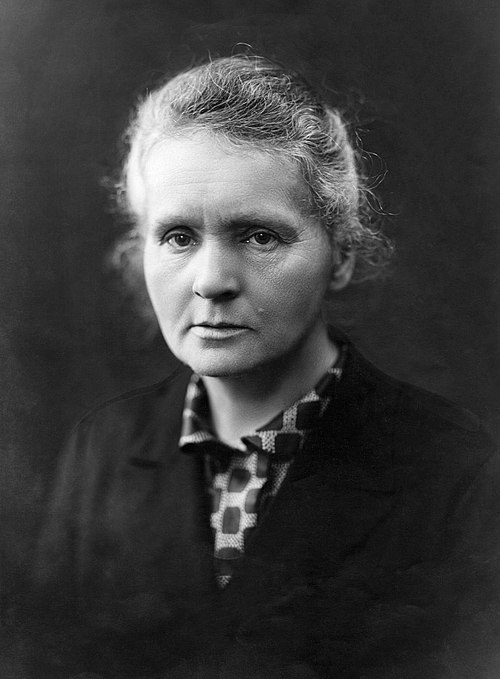Facts for Kids
Marie Curie was a pioneering physicist and chemist known for her groundbreaking research on radioactivity, becoming the first woman to win Nobel Prizes in two scientific fields.
Overview
Nobel Prizes
Legacy And Honors
Impact On Medicine
Research Methodologies
Challenges And Struggles
Early Life And Education
Scientific Contributions
Influence On Future Scientists

Inside this Article
Henri Becquerel
Jennifer Doudna
Radioactivity
World War I
Resilience
Chemistry
November
Building
Uranium
Did you know?
🔬 Marie Curie was the first woman to win a Nobel Prize.
🌍 She was born on November 7, 1867, in Warsaw, Poland.
⚛️ Curie discovered the elements polonium and radium.
🏆 She won Nobel Prizes in both Physics (1903) and Chemistry (1911).
💡 Marie Curie conducted pioneering research on radioactivity.
📚 Curie was the first person ever to win Nobel Prizes in two different scientific fields.
👩🔬 She was a co-founder of the Curie Institutes in Paris and Warsaw.
👶 Marie Curie was the first female professor at the University of Paris.
🥇 Her research contributed significantly to the development of X-rays in surgery.
🎓 Marie Curie's work laid the foundation for advances in nuclear physics and cancer treatments.
Introduction
She was the first woman to win a Nobel Prize and is famous for her work in radioactivity. 🌟
Marie's discoveries helped people understand atoms and even led to new medical treatments. She was not only a scientist but also a pioneer who opened doors for women in science! 🧪
Her family supported her learning, and she later moved to France, where she continued her important work. In her lifetime, she won two Nobel Prizes in different fields! 🌍
Nobel Prizes
The first was in 1903 when she won the Nobel Prize in Physics, sharing it with her husband Pierre Curie and Henri Becquerel for their work on radioactivity. 🎉
The second was in 1911, when she won the Nobel Prize in Chemistry for isolating radium and studying its properties. ⚛
️ This made her the first person ever to win Nobel Prizes in two different scientific fields! 🌟
She truly showed that women can achieve great things in science, paving the way for future generations!
Legacy And Honors
Many schools, research facilities, and even a beautiful museum in Paris are named after her. 🎓
She is celebrated every year on November 7th, which is known as Marie Curie Day. 🌟
In 2011, she was honored with a Google Doodle on her 144th birthday! Kids and adults alike remember her story, inspiring them to explore science. Marie’s discoveries still help today’s scientists and doctors. Her courage and determination continue to motivate women in science, making her a true superstar! 🌈
Impact On Medicine
Her work led to the discovery that radium could treat diseases like cancer. 💖
In World War I, she even helped set up mobile X-ray units to assist injured soldiers. 🚑
Marie trained doctors to use these machines, making it easier to find broken bones and other injuries. Her discoveries began a new era in medicine, called radiotherapy, which uses radiation to kill cancer cells and help people heal! 🌈
She saved many lives through her work and inspired countless others in healthcare.
Research Methodologies
She spent long hours in her laboratory, carefully conducting experiments. 🧪
She used very simple tools to study the properties of uranium and radium, like a scale to weigh samples and a glass tube for experiments. Marie also kept detailed notes about her findings. 📑
Her method of documenting everything helped other scientists understand her work better. By being so thorough and organized, she didn't just find new elements but also created a method for future scientists to follow. 📝
Challenges And Struggles
Being a woman in science during the late 1800s and early 1900s was tough, as many people didn’t think women could be scientists. 🚺
She often had to prove herself and worked harder than her male colleagues. Marie also faced personal struggles, like losing her husband, Pierre, in an accident. 💔
Instead of giving up, she continued their work and even raised two daughters while pursuing her studies! Her strong spirit and resilience showed that no obstacle was too big to overcome! ✨
Early Life And Education
In Poland, she was very curious about science and especially interested in physics and chemistry. She studied hard at her local school, but women couldn't attend university there! 🚫
So, Marie moved to Paris, France, to study at Sorbonne University, where she earned her degree in 1893. 🎓
It wasn't easy because she had to work several jobs to pay for her schooling. But her determination paid off, and she became one of the most respected scientists in the world! 🌟
Scientific Contributions
She found polonium in 1898 and named it after her homeland, Poland. 🇵🇱 In the same year, she discovered radium, which is very important in studying radiation. Marie's research showed how these elements emitted energy in the form of radiation. 📡
This groundbreaking work helped scientists understand radioactivity, a term she coined herself! Marie Curie’s discoveries changed how we look at the building blocks of matter. 🔬
Influence On Future Scientists
🔬 She showed them that they can be scientists too! Schools, books, and movies tell her story, encouraging kids to explore science and technology. 🌌
Her work on radioactivity laid the foundation for many scientific fields, including physics and medicine. 🌏
Today, women like Dr. Jennifer Doudna, who helped develop CRISPR technology, credit Marie's achievements for paving the way in science! 🌼
Because of her example, many young scientists dream big and work hard to change the world! ✨

